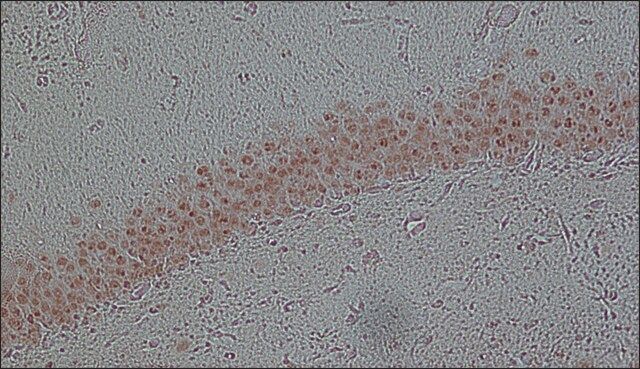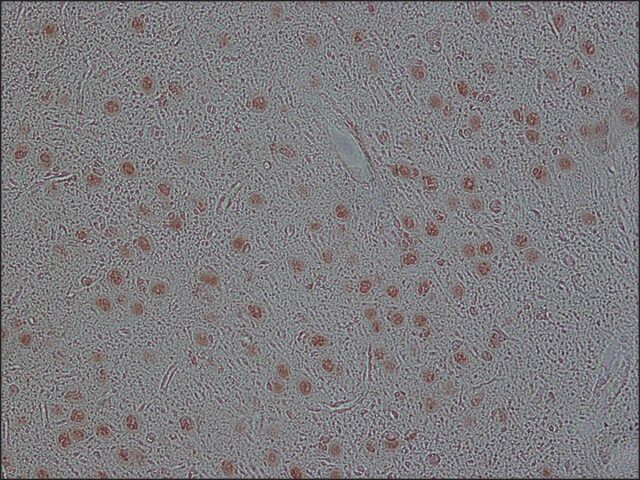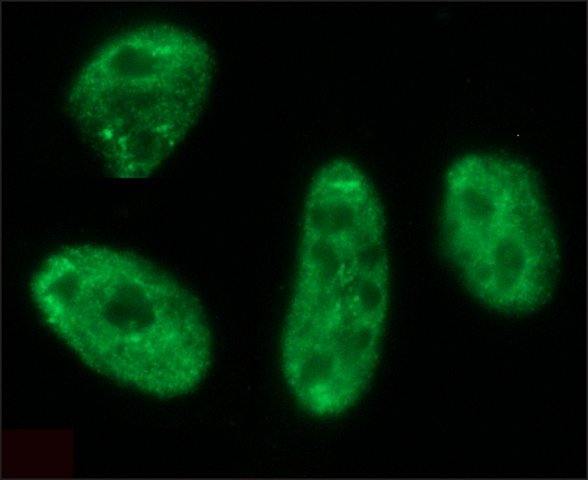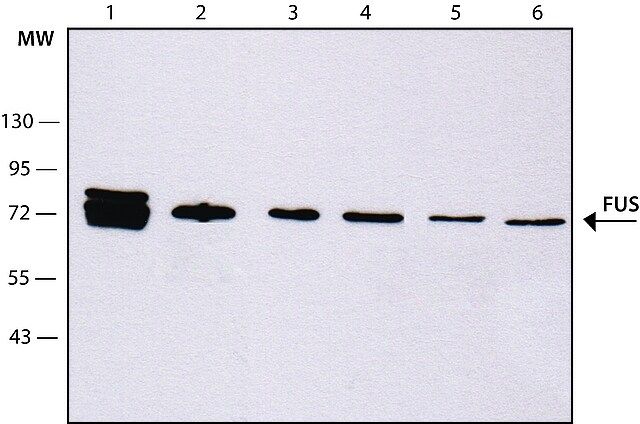您的位置:首页 > 产品中心 > Monoclonal Anti-FUS antibody produced in mouse
Monoclonal Anti-FUS antibody produced in mouse

| 产品编号: | 3145332 |
| 规格: | clone FUS-4, tissue culture supernatant |
| 包装规格: | 200 μL |
| 产品类别: | 进口试剂 |
| 品牌: | Sigma-Aldrich |
| 优惠价: | 立即咨询 |
产品别名
Monoclonal Anti-FUS antibody produced in mouse
Monoclonal Anti-POMP75
Monoclonal Anti-fusion gene in myxoid liposarcoma
Monoclonal Anti-TLS
Monoclonal Anti-FUS1
Monoclonal Anti-fused in sarcoma
Monoclonal Anti-translocated in liposarcoma protein
Monoclonal Anti-ALS6
Monoclonal Anti-75 kDa DNA-pairing protein
Monoclonal Anti-HNRNPP2
Monoclonal Anti-heterogeneous nuclear ribonucleoprotein P2
基本信息
| NACRES | NA.41 |
| General description【一般描述】 | Monoclonal Anti-FUS (mouse IgM isotype) is derived from the hybridoma FUS-4 produced by the fusion of mouse myeloma cells and splenocytes from BALB/c mice immunized with a synthetic peptide corresponding to an internal sequence of human FUS, conjugated to KLH. Fused in sarcoma (FUS), also known as translocated in liposarcoma (TLS), ribonucleoprotein (RNP)-P2, amyotrophic lateral sclerosis-6 (ALS6), is a RNA/DNA binding protein. FUS is normally located predominantly in the nucleus whereas, pathological FUS inclusions are mostly found in the cytosol of neurons and glia cells. |
| Immunogen【免疫原】 | synthetic peptide corresponding to an internal sequence of human FUS, conjugated to KLH. The corresponding sequence is identical in monkey and differs by 3 amino acids in mouse and rat. |
| Application【应用】 | Monoclonal Anti-FUS antibody produced in mouse has been used in various immunochemical techniques including:
|
| Biochem/physiol Actions【生化/生理作用】 | Fused in sarcoma (FUS) plays a vital role in transcription, RNA splicing and transport and is implicated in multiple diseases. Mutations in TAR DNA binding protein 43 (TDP-43) and FUS is associated with the development of amyotrophic lateral sclerosis (ALS) and fronto-temporal lobar degeneration (FLTD) including ubiquitin-positive inclusions (FLTDU). The majority of the FUS mutations has been recognized in C-terminal nuclear localization signal (NLS). FUS has been implicated in a broadening spectrum of neurodegenerative disorders. FUS has been identified as a component of inclusion bodies in patients with Huntington′s disease (HD) and spinocerebellar ataxias (SCA1-3). |
| Physical form【外形】 | Culture supernatant solution containing 15 mM sodium azide. |
产品性质
| Quality Level【质量水平】 | 200 |
| biological source【生物来源】 | mouse |
| conjugate【偶联物】 | unconjugated |
| antibody form【抗体形式】 | tissue culture supernatant |
| antibody product type | primary antibodies |
| clone【克隆】 | FUS-4, monoclonal |
| form【形式】 | buffered aqueous solution |
| mol wt【分子量】 | antigen ~70 kDa |
| species reactivity | mouse, human, rat |
| technique(s) | immunohistochemistry: 1:500-1:1000 using formalin-fixed and paraffin embedded rat cerebellum. indirect immunofluorescence: 1:200-1:400 using using HeLa or HepG2 cells. western blot: 1:1000-1:2000 using lysates of G361 cells. |
| isotype【同位素/亚型】 | IgM |
| UniProt accession no.【UniProt登记号】 | P35637 |
| shipped in【运输】 | dry ice |
| storage temp.【储存温度】 | −20℃ |
| Gene Information | human ... FUS(2521) mouse ... Fus(233908) rat ... Fus(317385) |
产品说明
| Disclaimer【免责声明】 | Unless otherwise stated in our catalog or other company documentation accompanying the product(s), our products are intended for research use only and are not to be used for any other purpose, which includes but is not limited to, unauthorized commercial uses, in vitro diagnostic uses, ex vivo or in vivo therapeutic uses or any type of consumption or application to humans or animals. |
安全信息
| Storage Class Code【储存分类代码】 | 12 - Non Combustible Liquids |
| WGK | WGK 2 |







